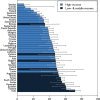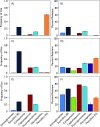Tracking global trends in the effectiveness of antibiotic therapy using the Drug Resistance Index
- PMID: 31139449
- PMCID: PMC6509601
- DOI: 10.1136/bmjgh-2018-001315
Tracking global trends in the effectiveness of antibiotic therapy using the Drug Resistance Index
Abstract
Background: Evaluating trends in antibiotic resistance and communicating the results to a broad audience are important for dealing with this global threat. The Drug Resistance Index (DRI), which combines use and resistance into a single measure, was developed as an easy-to-understand measure of the effectiveness of antibiotic therapy. We demonstrate its utility in communicating differences in the effectiveness of antibiotic therapy across countries.
Methods: We calculated the DRI for countries with data on antibiotic use and resistance for the disease-causing organisms considered by the WHO as priority pathogens: Acinetobacter baumannii, Escherichia coli, Klebsiella pneumoniae, Pseudomonas aeruginosa, Staphylococcus aureus, Enterococcus faecium and Enterococcus faecalis. Additionally, we estimated pooled worldwide resistance rates for these pathogens.
Results: 41 countries had the requisite data and were included in the study. Resistance and use rates were highly variable across countries, but A. baumannii resistance rates were uniformly higher, on average, than other organisms. High-income countries, particularly Sweden, Canada, Norway, Finland and Denmark, had the lowest DRIs; the countries with the highest DRIs, and therefore the lowest effectiveness of antibiotic therapy, were all low-income and middle-income countries.
Conclusions: The DRI is a useful indicator of the problem of resistance. By combining data on antibiotic use with resistance, it captures a snapshot of how the antibiotics a country typically uses match their resistance profiles. This single measure of the effectiveness of antibiotic therapy provides a means of benchmarking against other countries and can, over time, indicate changes in drug effectiveness that can be easily communicated.
Keywords: Antibiotic resistance; Onehealth; antibiotic consumption; low- and middle-income countries; public health.
Conflict of interest statement
Competing interests: None declared.
Figures




Comment in
-
The proposed Drug Resistance Index (DRI) is not a good measure of antibiotic effectiveness in relation to drug resistance.BMJ Glob Health. 2019 Aug 21;4(4):e001838. doi: 10.1136/bmjgh-2019-001838. eCollection 2019. BMJ Glob Health. 2019. PMID: 31543998 Free PMC article. No abstract available.
References
LinkOut - more resources
Full Text Sources
